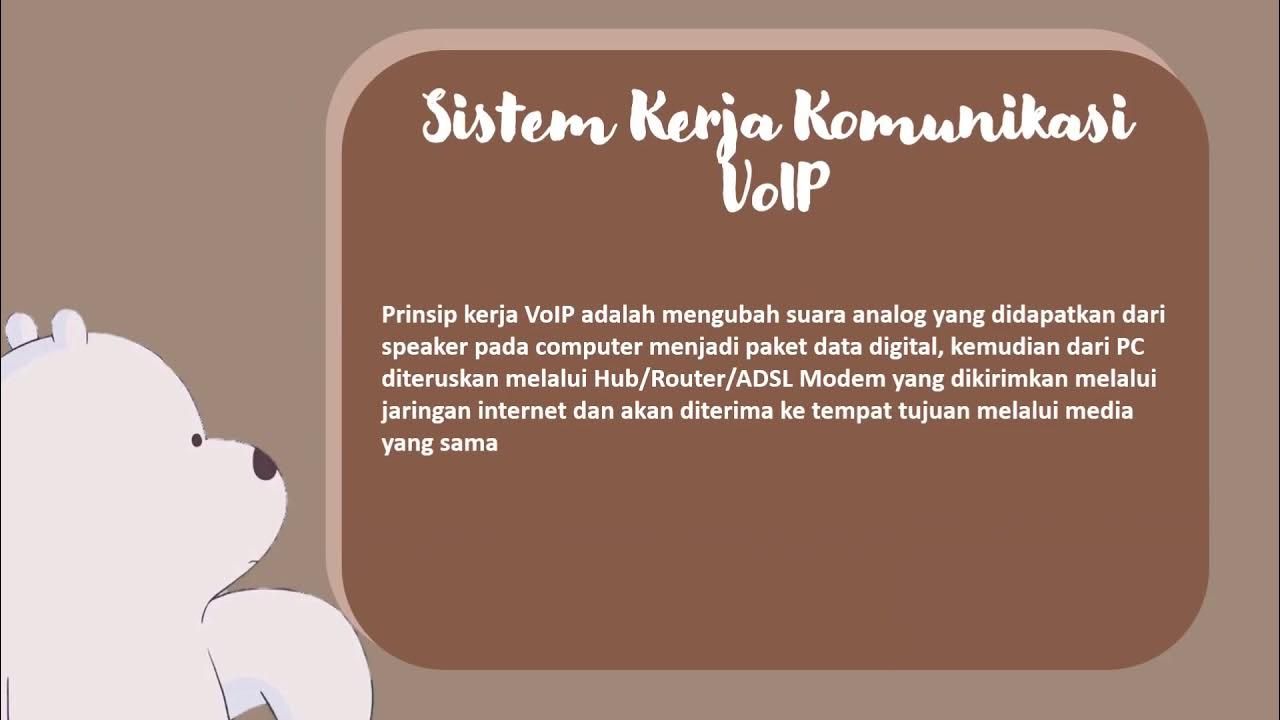CARA KERJA VOIP.. Sebenarnya Bagaimana????
Summary
TLDRThis video explains the concept of VoIP (Voice Over Internet Protocol), a technology that allows voice communication over internet and intranet networks. It highlights how VoIP converts analog voice signals into digital data, which is transmitted over the network and then converted back into analog at the receiver’s end. The video also differentiates between the internet, a global network, and the intranet, a private, localized network. Overall, the script provides a comprehensive yet accessible explanation of how VoIP functions and its significance in modern communication systems.
Takeaways
- 😀 VoIP (Voice Over Internet Protocol) enables long-distance voice communication over networks, including the internet and intranet.
- 😀 The internet connects devices globally, whereas an intranet connects devices within a specific network, such as a company's network.
- 😀 VoIP technology converts analog voice signals into digital data, which can then be transmitted over the network using data packets.
- 😀 VoIP relies on digital packet switching rather than traditional analog circuits used in standard telephony.
- 😀 The process begins when the user's voice is captured by a microphone, converted into digital data by an IP PBX server, and then transmitted over the network.
- 😀 Data is transferred from the sender's device to a server, which routes it to the recipient's device, where it is converted back into an analog signal.
- 😀 An IP PBX server plays a key role in the conversion process, acting as a bridge between analog and digital communication.
- 😀 The main advantage of VoIP is its ability to deliver voice communications over the internet or intranet at a much lower cost than traditional phone services.
- 😀 VoIP technology supports both personal and business communications, enabling efficient and cost-effective calls across long distances.
- 😀 The conversion process between analog and digital signals in VoIP allows for high-quality communication without the need for analog circuits.
- 😀 Understanding the process of analog-to-digital conversion and packet switching is key to grasping how VoIP technology functions efficiently.
Q & A
What is VoIP (Voice over Internet Protocol)?
-VoIP is a technology that allows voice communication over a network, such as the internet or an intranet, by converting voice signals into digital data packets, which are then transmitted over the network.
What is the difference between the internet and intranet?
-The internet is a global network that connects devices worldwide, whereas an intranet is a private network that connects devices within a single organization or building.
How does VoIP work in simple terms?
-VoIP works by converting analog voice signals into digital data, sending them through the network as data packets, and then converting them back into analog signals at the receiving end.
What role does a server play in the VoIP process?
-In VoIP, a server like an IP PBX (Private Branch Exchange) handles the conversion of voice signals into digital packets, manages the data transmission, and ensures proper routing between the calling and receiving clients.
What is the significance of the conversion from analog to digital in VoIP?
-The conversion from analog to digital allows voice signals to be transmitted efficiently over the network. Analog signals are converted into digital data packets that can be sent through the internet or intranet, reducing signal loss and improving communication quality.
How are voice signals transmitted in VoIP between two clients?
-When one client makes a call, their voice is captured by a microphone, converted into digital data by the IP PBX server, and transmitted as data packets to the receiving client, where it is converted back into analog signals and played through a speaker.
What happens to the voice signal once it reaches the receiving client?
-The digital voice data is received by the second client, where it is converted back into an analog signal that can be heard through the speaker. This process ensures that the voice sounds natural to the receiving user.
What is the role of the IP PBX server in VoIP communication?
-The IP PBX server acts as the intermediary that manages the communication between clients. It converts the analog voice signals into digital data packets, sends them across the network, and converts them back to analog signals at the receiving end.
Can VoIP be used for communication over the internet and intranet?
-Yes, VoIP can be used for communication over both the internet and intranet. The main difference is that the internet allows for global communication, while the intranet is limited to a specific organization or building.
Why is the conversion from digital back to analog important in VoIP?
-The conversion from digital back to analog is important because it ensures that the voice data can be heard in a recognizable form through traditional audio output devices like speakers or headphones.
Outlines

Dieser Bereich ist nur für Premium-Benutzer verfügbar. Bitte führen Sie ein Upgrade durch, um auf diesen Abschnitt zuzugreifen.
Upgrade durchführenMindmap

Dieser Bereich ist nur für Premium-Benutzer verfügbar. Bitte führen Sie ein Upgrade durch, um auf diesen Abschnitt zuzugreifen.
Upgrade durchführenKeywords

Dieser Bereich ist nur für Premium-Benutzer verfügbar. Bitte führen Sie ein Upgrade durch, um auf diesen Abschnitt zuzugreifen.
Upgrade durchführenHighlights

Dieser Bereich ist nur für Premium-Benutzer verfügbar. Bitte führen Sie ein Upgrade durch, um auf diesen Abschnitt zuzugreifen.
Upgrade durchführenTranscripts

Dieser Bereich ist nur für Premium-Benutzer verfügbar. Bitte führen Sie ein Upgrade durch, um auf diesen Abschnitt zuzugreifen.
Upgrade durchführen5.0 / 5 (0 votes)






